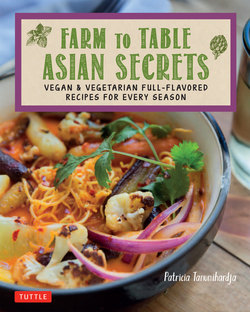Читать книгу Farm to Table Asian Secrets - Patricia Tanumihardja - Страница 9
На сайте Литреса книга снята с продажи.
ОглавлениеCooking Tips And Techniques
You don't have to go to culinary school to learn Asian cooking techniques. They are easy to learn; with practice, you'll be proficient in no time. All you need are a few simple Implements and tools you likely already have in your kitchen.
Steaming
Fill the steaming vessel (the bottom part) with a generous amount of water, perhaps 3 to 4 inches (7.5 to 10 cm) or as much water as it can comfortably accommodate. You don't want the water to touch the bottom of the steamer basket or plate.
Monitor the water level and replenish with boiling water if it gets precariously low before the food is cooked.
Place a kitchen towel under the lid to absorb condensation. This will prevent the water from dripping onto your food and making it soggy.
When the food is done, turn off the heat and wait for the steam to subside before lifting the lid. Lift it away from you so you don't scald yourself, and so that condensation doesn't drip onto the food.
You don't have to buy a steamer to steam foods properly. You can easily steam most foods in a stockpot with a pasta insert or an asparagus steamer. Or experiment with common kitchen implements you already have. All you need is a vessel to hold water, a way to suspend the food over the water, and a lid to keep the steam in (visit my blog : picklesandtea.org for more information). Here are two ideas:
Crisscross two wooden chopsticks inside a wok or pot and add enough water to reach just below the chopsticks. Bring to a boil and balance a shallow dish or pie plate on the chopsticks.
Place a trivet or a small upturned bowl in a wok or a big, wide pot. Place a shallow dish or pie plate on top. Add enough water to reach just below the trivet—don't submerge it. And don't worry if you hear the bowl or trivet knocking against the bottom of the wok as the water boils.
Deep-Frying
The oil should be 1½ to 2 inches (4 to 5 cm) deep in your pan (between 2 and 3 cups/500 to 750 ml of oil for a 14-inch/35-cm wok) so that the food can be fully immersed in the oil and float freely as it cooks.
Select an oil with a high smoke point—sunflower and peanut oil are good choices.
Buy a deep-fry thermometer to track optimum temperature; a candy thermometer works, too. For a visual indicator, dip a wooden chopstick into the oil; if bubbles gather around it, the oil should be hot enough. You can also test-fry a bread cube or a small portion of what you're cooking—it should bubble gracefully to the surface and sizzle gently. If it just sits there soaking up oil, wait a couple more minutes before starting.
Fry in batches so as to not overcrowd the pan. Overcrowding lowers the oil temperature and may lead to splattering or spillage.
Battered foods often leave debris in the oil. Use a slotted spoon or a wire-mesh strainer to remove leftover fried bits, and then bring the oil temperature back up again before frying next batch.
Stir-Frying
Always preheat your wok or pan to achieve good wok-searing action and to dry up any water droplets. I generally heat my wok to medium-high heat and then raise or lower it if I need to.
How do you know it's ready? Sprinkle some water onto the wok. The beads should dance on the surface and vaporize within a couple of seconds. You'll also see a wisp or two of smoke.
Chopsticks have many uses-I can even use them to lift a collapsible steamer basket.
After adding oil, throw in your first ingredient, usually garlic. If it sizzles gently and bubbles gather around its edges, you're ready to go. If it fries aggressively and starts burning, the oil is too hot. If it sits still, the oil isn't hot enough.
If the oil gets too hot and starts to smoke uncontrollably, remove the pan from the heat for a few seconds and lower the heat.
Don't overcrowd the pan. Putting too many ingredients in the pan lowers the temperature, and the foods will steam instead of sear. Add ingredients gradually, in small handfuls.
Adjust the heat after adding colder foods or liquids. Listen to the sizzle in your pan. If you hear too much sizzle, decrease the temperature; too little sizzle, increase the temperature.
Keep things moving swiftly around the wok; slide your spatula to the bottom and turn and toss ingredients up and over one another.
